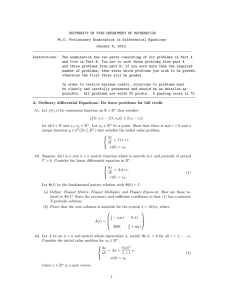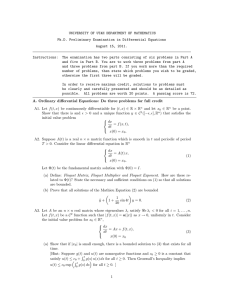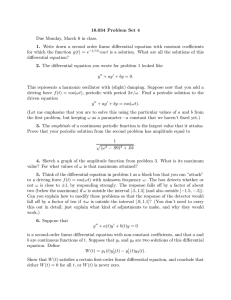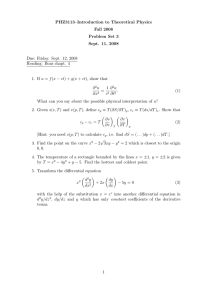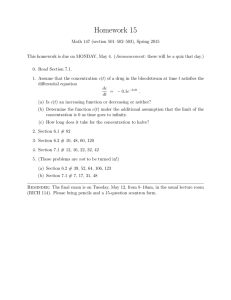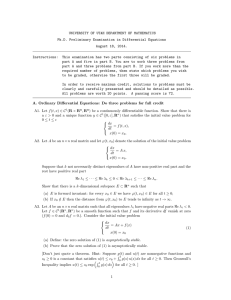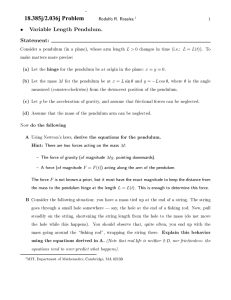UNIVERSITY OF UTAH DEPARTMENT OF MATHEMATICS January 5, 2011.
advertisement
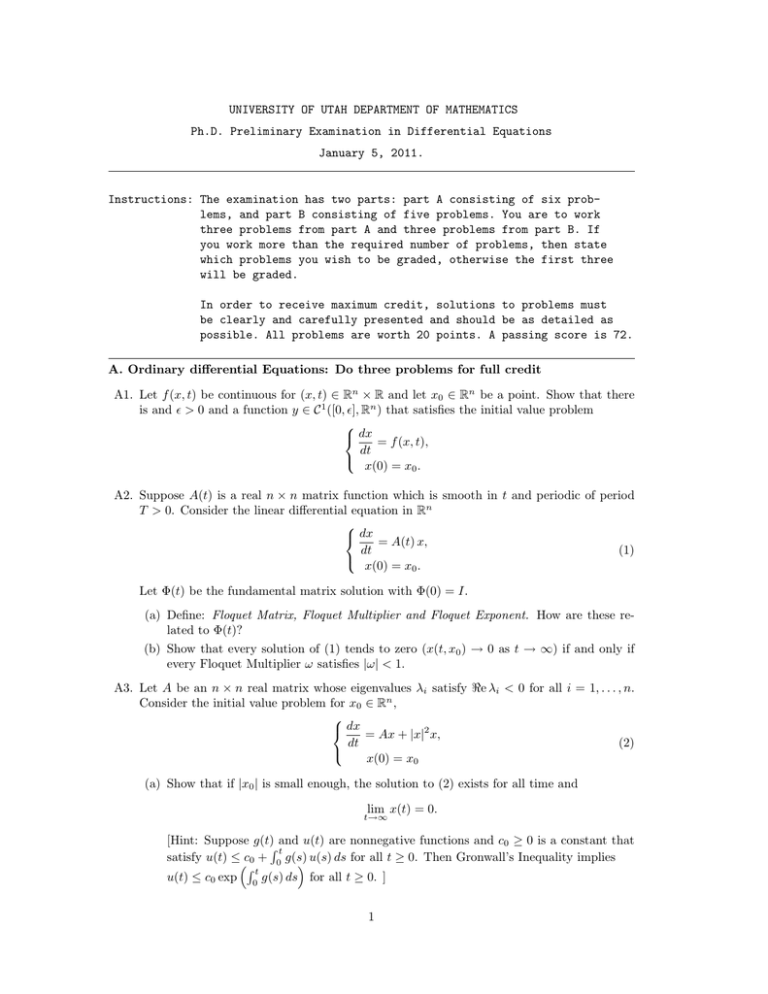
UNIVERSITY OF UTAH DEPARTMENT OF MATHEMATICS
Ph.D. Preliminary Examination in Differential Equations
January 5, 2011.
Instructions: The examination has two parts: part A consisting of six problems, and part B consisting of five problems. You are to work
three problems from part A and three problems from part B. If
you work more than the required number of problems, then state
which problems you wish to be graded, otherwise the first three
will be graded.
In order to receive maximum credit, solutions to problems must
be clearly and carefully presented and should be as detailed as
possible. All problems are worth 20 points. A passing score is 72.
A. Ordinary differential Equations: Do three problems for full credit
A1. Let f (x, t) be continuous for (x, t) ∈ Rn × R and let x0 ∈ Rn be a point. Show that there
is and > 0 and a function y ∈ C 1 ([0, ], Rn ) that satisfies the initial value problem
dx = f (x, t),
dt
x(0) = x0 .
A2. Suppose A(t) is a real n × n matrix function which is smooth in t and periodic of period
T > 0. Consider the linear differential equation in Rn
dx = A(t) x,
dt
(1)
x(0) = x0 .
Let Φ(t) be the fundamental matrix solution with Φ(0) = I.
(a) Define: Floquet Matrix, Floquet Multiplier and Floquet Exponent. How are these related to Φ(t)?
(b) Show that every solution of (1) tends to zero (x(t, x0 ) → 0 as t → ∞) if and only if
every Floquet Multiplier ω satisfies |ω| < 1.
A3. Let A be an n × n real matrix whose eigenvalues λi satisfy <e λi < 0 for all i = 1, . . . , n.
Consider the initial value problem for x0 ∈ Rn ,
dx = Ax + |x|2 x,
dt
(2)
x(0) = x0
(a) Show that if |x0 | is small enough, the solution to (2) exists for all time and
lim x(t) = 0.
t→∞
[Hint: Suppose g(t) and u(t) are nonnegative functions and c0 ≥ 0 is a constant that
Rt
satisfy u(t) ≤c0 + 0 g(s)
u(s) ds for all t ≥ 0. Then Gronwall’s Inequality implies
Rt
u(t) ≤ c0 exp 0 g(s) ds for all t ≥ 0. ]
1
(b) Let z(t) = 0 for all t be the zero solution. Define what it means for z to be Asymptotically Stable. Show that z is asymptotically stable for this equation.
A4. Suppose that H : R2 → R is a smooth function. Consider the Hamiltonian System
ẋ = Hy (x, y)
ẏ = −Hx (x, y).
Suppose that Γ0 is a nonconstant periodic orbit for this system. Show that Γ0 cannot be
Asymptotically Orbitally Stable. (This is sometimes referred to as asymptotic stability of
the periodic orbit Γ0 or asymptotic Poincarè stability.)
A5. Determine whether the planar system
ẋ = x − x3 − xy 2 ,
ẏ = 2y − y 5 − yx4
has any nonconstant periodic solutions.
A6. (a) State the Center Manifold Theorem for rest points. Briefly explain its importance in
bifurcation theory.
(b) Construct an approximation to the center manifold at the origin and use it to determine
the local behavior of solutions.
ẋ = −y − xz,
ẏ = x − y 3 ,
ż = −z − 2xy − 2x4 + x2 .
B. Partial Differential Equations. Do three problems to get full credit
B1. Suppose that u ∈ C 2 solves
utt − div(aDu) = 0,
where a ∈ C 1 (Rn ) satisfies
1
2
in Rn × (0, ∞),
≤ a(x) ≤ 1 for all x.
(a) Assunimg suppx u(x, t) ⊂ B(0, R) ⊂ Rn for all 0 ≤ t ≤ T , show that the energy
Z
1
E(t) =
u2 + a|Du|2 dx,
0 ≤ t ≤ T,
2 Rn t
is conserved.
(b) Using an appropriately defined local energy, establish that solutions exhibit finite propagation speed: if for some r > 0, u(x, 0) and ut (x, 0) are zero for x ∈ B(x0 , r) ⊂ Rn ,
then u is zero in the cone K = {(x, t) : 0 ≤ t ≤ r, |x − x0 | < r − t}.
B2. The time-dependent Schrödinger equation can be written
i ut = − ∆ u + V u,
where u(x, t), x ∈ Rn , t ∈ R, is the complex-valued “wave function,” and V (x) ≥ 0 is a
given continuous real-valued potential function.
(a) Using complex exponential plane waves, describe the dispersion relation for this equation in case V ≡ 1. Is this problem dispersive?
2
(b) Assuming V is bounded, and the problem is formulated over the smooth bounded
connected spatial domain U ⊂ Rn , with homogeneous Dirichlet boundary conditions,
prove that the solutions to the time dependent problem can be expressed as a discrete
sum involving solutions to the time-independent problem
Ek φk = ∆ φk + V φk ,
in U
where 0 < E1 ≤ E2 ≤ · · · .
B3. Consider Burger’s equation
ut +
u2 2
in R × (0, ∞),
= 0,
x
on R × {0}.
u = g,
(a) Construct an integral solution satisfying the Rankine-Hugoniot condition which exhibits “nonphysical shocks.”
(b) Write down the explicit entropy condition for this problem and explain why it rules
out the solution in part (a).
(c) Construct another integral solution which satisfies the entropy condition, and explain
why this condition does not allow shocks.
B4. Let A(x) be an n × n matrix-valued function defined on the smooth bounded connected
domain U ⊂ Rn . Assume A(x) = (ai,j (x)) is uniformly symmetric positive definite, and
ai,j ∈ C ∞ (U ) for all 1 ≤ i, j ≤ n. Consider the problem
− div(ADu) = λu,
in U ,
u = 0,
on ∂U .
(a) Characterize the principal (smallest) eigenvalue λ1 in terms of the Rayleigh quotient
for this problem.
(b) Prove that λ1 > 0, and that the associated eigenfunction u1 is a minimizer of the
Rayleigh quotient.
B5. Consider the problem
t ∈ (0, 1), x ∈ (0, 1),
ut = uxx ,
u(0, t) = u(1, t) = 0,
t ∈ (0, 1),
u(x, 1) = f,
x ∈ (0, 1).
(a) What are the least restrictive condition you can find on f which guarantee that the
problem admits a solution u, bounded in the norm
Z
kukB = sup
t∈[0,1]
1
1/2
u(x, t) dx
?
2
0
(b) Under what conditions on f does the stability estimate
kukB ≤ Ckf kL2 (0,1)
hold?
(c) Assuming u ∈ C 2 (U1 ), where U1 = (0, 1)×(0, 1], is uniqueness of solutions guaranteed?
(Error corrected 6-28-11.)
3
